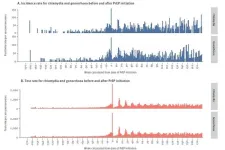(Press-News.org) Researchers at Karolinska Institutet, in collaboration with JLP Health and others, have identified how the tick-borne Crimean-Congo haemorrhagic fever virus enters our cells. The results are published in Nature Microbiology and are an important step in the development of drugs against the deadly disease.
Crimean-Congo haemorrhagic fever virus (CCHF virus) is spread through tick bites and can cause haemorrhagic fever. The disease is serious and has a mortality rate of up to 40 per cent depending on the health status of the person infected. Common symptoms include fever, muscle pain, abdominal pain, joint pain, vomiting and haemorrhaging that can cause organ failure.
The disease has spread to Europe
The virus is present in around 40 countries, including Central Asia, the Middle East and parts of Africa. In recent years, the disease has spread to new geographical areas as a result of climate change, including Spain and France. The tick species that can spread the disease has also been observed in Germany and Sweden. There are currently no effective treatments for the disease.
In a new study, researchers at Karolinska Institutet in Sweden and others have found that the virus enters our cells via a protein on the cell surface, the so-called LDL receptors that regulate blood cholesterol levels.
To identify the protein, the researchers used human mini-organs grown in test tubes and an advanced stem cell library from JLP Health. The same platform has previously been used to identify how the Ebola virus enters cells.
The results were also confirmed in tests on mice, which showed that mice lacking the LDL receptor did not get as sick as others.
Researchers want to trick the virus
The discovery is an important step towards developing drugs for Crimean-Congo haemorrhagic fever, according to Ali Mirazimi, adjunct professor at the Department of Laboratory Medicine, Karolinska Institutet, and one of the researchers behind the study.
“Once we know which receptor the virus uses, we can produce the receptor in test tubes and administer it as a drug,” he says. “Then we can trick the virus into binding to those receptors instead of to the cells and thus stop the virus from spreading in our bodies.”
This knowledge is essential if the disease were to become more common and spread to new areas. Normally it takes many years to develop a drug, but the COVID-19 pandemic and the development of the SARS-CoV-2 vaccine showed that it can be done much faster if everyone decides it is a priority.
Ticks are spread by migratory birds
“This is an important step in our preparedness for the disease,” says Ali Mirazimi. “Crimean-Congo haemorrhagic fever is a disease we would rather not have. The ticks are spread by migratory birds and have already been found in Sweden. If the disease starts appearing in more places, we may already have a drug that we can take into clinical trials.”
The research was conducted in collaboration with the Medical University of Vienna, Austria, Helmholtz Centre for Infection Research, Germany, the National Institutes of Health, USA, and the company JLP Health. It was financed mainly by the Swedish Research Council and the EU. No conflicts of interest have been reported.
Publication: 'Crimean-Congo Hemorrhagic Fever virus uses LDLR to bind and enter host cells', Vanessa M. Monteil, Shane C. Wright Matheus Dyczynski, Max J. Kellner, Sofia Appelberg, Sebastian W. Platzer, Ahmed Ibrahim, Hyesoo Kwon, Ioannis Pittarokoilis, Mattia Mirandola, Georg Michlits, Stephanie Devignot, Elizabeth Elder, Samir Abdurahman, Sándor Bereczky, Binnur Bagci, Sonia Youhanna, Teodor Aastrup, Volker M. Lauschke, Cristiano Salata, Nazif Elaldi, Friedemann Weber, Nuria Monserrat, David W. Hawman, Heinz Feldmann, Moritz Horn, Joseph M. Penninger, Ali Mirazimi, Nature Microbiology, online 28 March 2024, doi: 10.1038/s41564-024-01672-3.
END
New study shows how the Crimean-Congo hemorrhagic fever virus enters our cells
2024-03-28
ELSE PRESS RELEASES FROM THIS DATE:
Neoadjuvant chemotherapy proves effective for locally advanced penile squamous cell carcinoma
2024-03-28
In a recent multi-center study published in the Journal of the National Cancer Institute, researchers examined the effects of neoadjuvant chemotherapy (NAC) on patients suffering from locally advanced penile squamous cell carcinoma (PSCC). Dr. Kyle Rose, urologic oncologist at Ochsner MD Anderson Cancer Center, was the lead author for the publication.
The research included a cohort of 209 patients undergoing NAC, targeting locally advanced and clinically node positive PSCC. The patient group showed a diverse range of disease severity, with a distribution including 7% with stage II, 48% with stage III, and 45% with stage IV PSCC, ...
Study flips treatment paradigm in bilateral Wilms tumor, shows resistance to chemotherapy may point toward favorable outcomes
2024-03-28
(MEMPHIS, Tenn. – March 28, 2024) Resistance to chemotherapy is typically associated with poor outcomes for patients with cancer. However, St. Jude Children’s Research Hospital scientists demonstrated that in bilateral Wilms tumor (cancer in both kidneys) chemotherapy resistance can point toward a more favorable histology and an ultimatelygood outcome. The study revealed that tumors that do not respond to neoadjuvant, or tumor-shrinking, chemotherapy are predominantly ...
Doctors received approximately $12.1 billion from drug and device makers between 2013-2022
2024-03-28
HERSHEY, Pa. — Despite evidence that financial conflicts of interest may influence medical practice and research and may erode patient trust in medical professionals, these relationships remain pervasive. According to a new analysis of the Open Payments platform, a database that tracks payments between physicians and industry, a team led by a Penn State researcher found that doctors received approximately $12.1 billion from drug and device makers between 2013 and 2022.
Their findings published today (March 28) in JAMA. It’s one of the first studies to look at industry payments longitudinally and by specialty.
“Overall, ...
Discovery suggests new strategy against follicular lymphoma
2024-03-28
A team led by researchers at Weill Cornell Medicine has identified important drivers of the transformation of a type of blood cancer called follicular lymphoma from a slow-growing form to the aggressive form it takes in some patients.
The study, published March 7 in Cancer Cell, showed that while mutations affecting a gene-regulating complex called BAF can put the cancer on a dangerous trajectory, they also make follicular lymphoma highly susceptible to experimental BAF-inhibitor drugs.
“These encouraging findings could address critical and urgent challenges with this disease and have prompted us to begin planning clinical trials ...
Making the future too bright: how wishful thinking can point us in the wrong direction
2024-03-28
Everyone indulges in wishful thinking now and again. But when is that most likely to happen and when could it actually be harmful? A new study, led by the University of Amsterdam (UvA), demonstrates unequivocally that the greater the insecurity and anxiety of a situation, the more likely people are to become overly optimistic – even to the point where it can prevent us from taking essential action. The study's results have now been published in the journal American Economic Review.
‘People aren't purely truth-seekers - many beliefs are influenced by ...
Ochsner Health named to Newsweek’s America’s Greatest Workplaces 2024 for Job Starters
2024-03-28
NEW ORLEANS, La – Newsweek and Plant-A Insights Group have named Ochsner Health one of America's Greatest Workplaces for Job Starters in 2024. In a survey that included more than 75,000 young professionals and more than 540,000 company reviews, Ochsner earned 5 out of 5 stars. As the leading not-for-profit healthcare provider in the Gulf South, Ochsner is committed to championing career development among new professionals.
"We at Ochsner are honored to receive recognition as a place of employment that offers ...
Three-year study of young stars with NASA’s Hubble enters new chapter
2024-03-28
In the largest and one of the most ambitious Hubble Space Telescope programs ever executed, a team of scientists and engineers collected information on almost 500 stars over a three-year period. This effort offers new insights into the stars' formation, evolution, and impact on their surroundings.
This comprehensive survey, called ULLYSES (Ultraviolet Legacy Library of Young Stars as Essential Standards), was completed in December 2023, and provides a rich spectroscopic dataset obtained in ultraviolet light that astronomers will be mining for decades to come. Because ultraviolet light can ...
North Carolina takes the lead in PFAs research with Collaboratory’s $3 million investment to expand the state’s research capacity
2024-03-28
WILMINGTON, N.C. (March 27, 2024) – The North Carolina Collaboratory – an organization dedicated to advancing scientific research for policymaking within North Carolina – today announced its partnership with Thermo Fisher Scientific to advance the State’s per- and polyfluoroalkyl substances (PFAS) research capabilities. Supported by critical appropriations from the North Carolina General Assembly (NCGA), the Collaboratory purchased five state-of-the-art mass spectrometers that continue to position North Carolina at the forefront of academic PFAS research nationally. This new partnership ...
Is it the school, or the students?
2024-03-28
Are schools that feature strong test scores highly effective, or do they mostly enroll students who are already well-prepared for success? A study co-authored by MIT scholars concludes that widely disseminated school quality ratings reflect the preparation and family background of their students as much or more than a school’s contribution to learning gains.
Indeed, the study finds that many schools that receive relatively low ratings perform better than these ratings would imply. Conventional ...
Exploring the relationship between HIV pre-exposure prophylaxis and the incidence of chlamydia, gonorrhea and syphilis – findings from Denmark
2024-03-28
In their research article published in Eurosurveillance, von Schreeb et al. challenge existing assumptions regarding the relationship between the use of HIV pre-exposure prophylaxis (PrEP) and the incidence of bacterial sexually transmitted infections (STI). According to the concept of sexual risk compensation, the start of PrEP treatment – a drug regimen which effectively prevents acquiring HIV – is associated with rises in STI as people feel protected against HIV while using it. However, von Schreeb et al. argue that available ...


